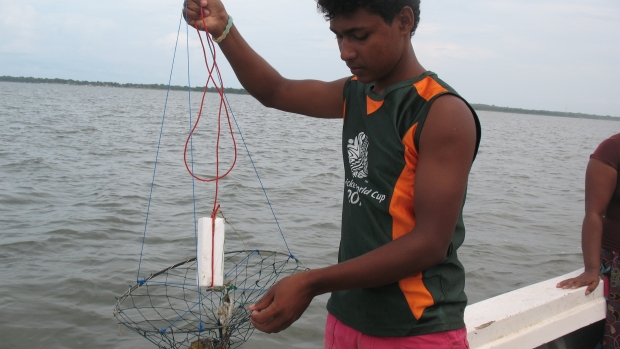Grants :: Small Grant Facilities :: Introducing and encouraging use traditional fishing gear for Mud Crab Fishery in Kokilai Lagoon
Introducing and encouraging use traditional fishing gear for Mud Crab Fishery in Kokilai Lagoon

Traditional Mud crab fishing trap, Kokilai lagoon © Kumudini Ekaratne, IUCN, 2012
Objectives
A sustainable mud crab fishing model is introduced to selected Kokilai fishers.
Background
Kokilai lagoon is well known for Mud Crab (Scylla serrata) and there are many families in the area depending on mud crab fishery. At present, most of them use nylon nets to catch mud crabs which result in damage to crab claws thus leading to less financial returns and destruction of the resource. The project will assist selected mud crab fishermen in sustainable crab fishery through providing and encouraging use of traditional crab traps which will help them in increasing their income. This method will also avoid by-catch, and thus will lead to conserving the lagoon reources.
There will be 3,000 traps operating in the lagoon and selected mud crab fishers will receive awareness on coastal resources and its valuable services, its limitations, sustainable utilization of resources. They will also be trained in keeping sales records and saving options.
Target beneficiaries
32 fishermen in Kokilai
Outputs
31 fishers engaged in mud crab fishery using 3,000 traditional crab traps.
Accomplishments and challenges
-
32 fishermen are engaged in mud crab fishery using the traditional fishing gear which reduce waste of fishery resources.
-
Household income of the mud crab fishermen in Kokilai village (who use mechanized boats) has increased by 10-15% and those from Karnaterkerney and Allampil (who use traditional canoes for fishing and recently resettled communities) by 30-40%.
Contributions to cross-cutting themes
The project recruited fishermen regardless their age group (except less than 18 years old) or any other social concerns. Women in this area generally do not get involve in fishing in the lagoon. However, the traditional method which was re-introduced could be practiced by women. Further, fisherwomen (wives of male beneficiaries) assisted in record keeping at household level.
Lessons Learned
- Introduction of traditional fishing gear can lead to enhance livelihood standards in fishing communities in Kokilai lagoon
- Traditional knowledge always support the project to bring good project outputs. For example, replacing iron rods for making the crab traps with galvanized rods (more durable)
- Beneficiaries should not be used for record keeping, if correct and comprehensive data is needed, Hiring a person to do this is more appropriate for accuracy and quality of record keeping.
Project Facts
Country
Location
Kokilai lagoon
Topic
Duration
1st Jun 2012 to 30th May 2013
MFF Grant Amount
LKR 890,000/=
Co-financing Partner
Beneficiaries: LKR 90,000
Grantee: LKR 253,000
Implementing Partner
Sewalanka Foundation,P.O. Box No 032nd Floor,No 432A, Colombo Rd,Boralasgamuwa,Sri LankaTel: + 94 2545362-4Fax: + 94 12545166
"Our average daily income is about USD 15-20. Having saved the income since July 2012, I purchased a cupboard (to keep clothes) and a gas cooker. Before having the gas cooker, we used to cut mangroves for fuel wood. This project while increasing our income will also lead to conserving mangroves in the vicinity of the Kokilai lagoon". P Madushanka